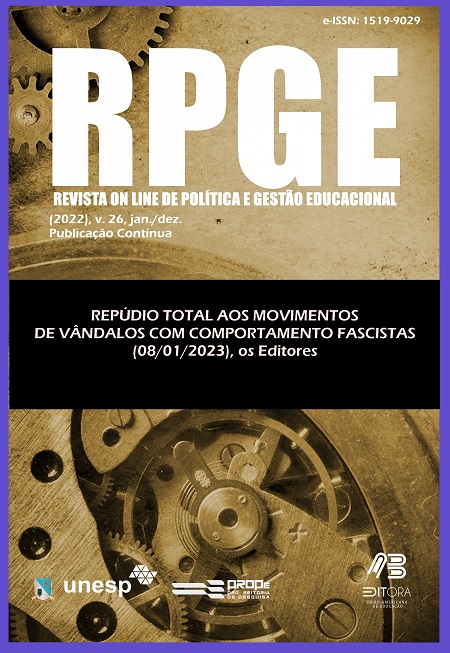Tipos de elaboración musical de conjunto y orquesta por clarnetistas como tecnologías pedagógicas
DOI:
https://doi.org/10.22633/rpge.v26i00.16466Palabras clave:
Características antropométricas, Velocistas, Saltadores, Atletismo, EducaciónResumen
La investigación aborda el problema pedagógico del uso de la creación musical colectiva. Los resultados de la evaluación de la observación pedagógica en dos grupos de estudiantes de 1er año en la universidad de música se utilizaron como materiales de investigación. La muestra representativa estuvo compuesta por 75 estudiantes seleccionados por muestreo mecánico. La metodología de investigación incluye los métodos de grupo científico general y métodos especiales: análisis de contenido de la literatura científica, el método de observación pedagógica incluida, el método de análisis estadístico utilizando el programa de análisis avanzado Neural Designer. En conclusión, la introducción de un conjunto educativo y una orquesta en el proceso de aprendizaje del clarinete permite enriquecer la experiencia musical-teórica y práctica interpretativa de los estudiantes de clarinete, para maximizar el repertorio de género-temático, técnico, educativo y artístico de clarinetistas, para formar en los participantes del conjunto didáctico experimental el pensamiento analítico variante y la capacidad de tomar una única decisión interpretativa y performativa.
Descargas
Citas
APRIAMOV, V. M. Methodical bases of music-making of clarinetists in an ensemble. South Russian Musical Almanac, v. 2, p. 83-96, 2017.
BATTIPAGLIA, V. A. The double-lip embouchure in clarinet playing. Journal of New Music Research, n. 49, n. 8, p. 36-49, 2019.
BORODINA, T. I. The role of the chamber ensemble in the education of performing musicians. Bulletin of the Tambov University. Series: Humanities, v. 4, p. 10-25, 2017.
ELLSWORTH, J. The Clarinet. Routledge, 2021. 308 p.
FROLOVA, N. A. The Pedagogical Potential of Modern Auto-didactics in the Process of Performing Training of Music Students. Siberian Pedagogical Journal, v. 1, p. 2-7, 2015.
GABRIEL, J. D.; COYLE, W. L. A method for automatic detection of tongued and slurred note transitions in clarinet playing. The Journal of the Acoustical Society of America, v. 146, n. 3, p. 238-244, 2019.
GABRIEL, J. D.; COYLE, W. L. Detecting articulations in clarinet playing. The Journal of the Acoustical Society of America, v. 145, n. 3, p. 1677-1689, 2019.
GORDEYEVA, E. V. The Practice of Ensemble Music-Making and the Baroque Clavier Musical Text. ICONI, n. 1, p.135-149, 2019.
HINTON, J. T. The clarinet (a teachers’ and students’ guide to the clarinet and clarinet playing). The world of science, culture, education, v. 6, p. 17-26, 2021.
KAMINSKAYA, E. A.; DEDOV, S. V. Music-making in a mixed ensemble as a pedagogical problem. The world of science, culture, education, v. 6, p. 187-190, 2021.
LAWRENCE, S. L. The status of the American school of clarinet playing. In book: BBC Music micro-bit Recipes, p. 247-275, 2021.
MINI, Z. The national style of variations on the themes of Subei for clarinet and piano by Zhang Wu in the context of Chinese composer’s creativity in 1949-1966. Manuscript, v. 10, p. 3-14, 2021.
NORTH, V. M. A handbook of suggestions for solutions to problems of beginners in clarinet playing. Journal of New Music Research, v. 52, n. 12, p. 16-28, 2020.
OLMOS, A.; BOUILLOT, N. A High-Fidelity Orchestra Simulator for Individual Musicians’ Practice. Computer Music Journal, v. 36, n. 2, p. 55-73, 2020.
PÀMIES-VILÀ, M.; HOFMANN, A. The influence of the vocal tract on the attack transients in clarinet playing. Journal of New Music Research, v. 49, n. 4, p. 1-10, 2020.
RASH B. In discussion: the clarinetists of Chineka. The Clarinet, v. 47/4, p. 32-49, 2020.
RYBALKO, E. A. Collective music-making as one of the directions of general musical education. Manuscript, v. 10, p. 15-21, 2021.
SCOTT, S. J. Playing Musical Instruments: A Resource for Teachers. In: Music Education for Children with Autism Spectrum Disorder. 2020. p. 169-210.
SERKOV, K. S. Playing in an ensemble as the most important component of learning to play wind instruments. Bulletin of musical science, v. 1, p. 151-157, 2020.
SLIS, A.; WOLAK, K.; NAMASIVAYAM, A. An exploratory study into different types of articulation in clarinet playing. A comparative analysis of tongue action in single-, double, and side-to-side staccato articulation types on the clarinet. 2017. 206 p.
STEPENKO, E. A. Constructive Interaction of Teacher and Student in the Process of Learning to Play the Clarinet as a Condition for Formation of Ensemble Music Culture. Uchenye Zapiski RGSU, v. 20, n. 2, p. 139-147, 2021.
TAILLARD, T. A. Theoretical and experimental study of the role of the reed in clarinet playing. Etude théorique et expérimentale du rôle de l'anche dans le jeu de la clarinette, v. 3, p. 27-39, 2018.
WEISS, A. E.; NUSSECK, M.; SPAHN, C. Motion types of ancillary gestures in clarinet playing and their influence on the perception of musical performance. Journal of New Music Research, v. 47, n. 6, p. 1-14, 2018.
YU, Z. Some milestones in the historical evolution of the clarinet: on the way to world fame. South Russian Musical Almanac, v. 2, p. 78-82, 2017.
ZAGURSKY, V. I. Vocal-ensemble component in the preparation of a musician: technological processes and creative principles. Scientific notes of the Crimean Federal University named after V. I. Vernadsky. Sociology. Pedagogy. Psychology, v. 3, p. 102-126, 2021.
Descargas
Publicado
Cómo citar
Número
Sección
Licencia
Derechos de autor 2022 Revista on line de Política e Gestão Educacional

Esta obra está bajo una licencia internacional Creative Commons Atribución-NoComercial-CompartirIgual 4.0.
Manuscritos aceitos e publicados são de propriedade da Revista on line de Política e Gestão Educacional. É vedada a submissão integral ou parcial do manuscrito a qualquer outro periódico. A responsabilidade do conteúdo dos artigos é exclusiva dos autores. É vedada a tradução para outro idioma sem a autorização escrita do Editor ouvida a Comissão Editorial Científica.











